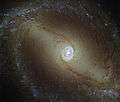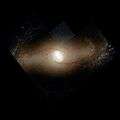NGC 1433
Coordinates: ![]() 03h 42m 01.553s, −47° 13′ 19.49″
03h 42m 01.553s, −47° 13′ 19.49″
| NGC 1433 (PGC 13586 - Miltron's Galaxy) | |
|---|---|
|
| |
| Observation data (J2000 epoch) | |
| Constellation | Horologium |
| Right ascension | 03h 42m 01.553s[2] |
| Declination | −47° 13′ 19.49″[2] |
| Redshift | 0.003590[2] |
| Helio radial velocity | 1076±1 km/s[3] |
| Distance | 32 Mly[4] |
| Apparent magnitude (V) | 9.99[2] |
| Apparent magnitude (B) | 10.84[2] |
| Characteristics | |
| Type | (R'_1)SB(rs)ab [3] |
| Apparent size (V) | 6′.5 × 5′.9[3] |
| Other designations | |
|
HIPASS J0342-47, QDOT B0340269-472245, [CHM2007] LDC 266, J034201.55-4713194, AM 0340-472, IRAS 03404-4722, SGC 034027-4722.8, [VDD93] 31, 6dFGS gJ034201.5-471319, LEDA 13586, SINGG HIPASS J0342-47, ESO 249-14, 2MASX J03420155-4713194, [A81] 034029-4724, ESO-LV 249-0140, PSCz Q03404-4722, [CHM2007] HDC 257 J034201.55-4713194 | |
NGC 1433 is a barred spiral galaxy with a double ring structure located in the constellation of Horologium. It is at a distance of 30 million light years from Earth. It has an active galactic nuclei, and NGC 1433 is a Seyfert galaxy that's also known as PGC 13586 which is named Miltron's Galaxy. The central region of the galaxy portraits intense star formation activity, with an irregular star-forming ring of 5" (or 0.3 kpc) radius and weak radio wave emission. Star formation is also noticeable in the spiral arms but not the bar of the galaxy.[5] NGC 1433 is being studied as part of a survey of 50 nearby galaxies known as the Legacy ExtraGalactic UV Survey (LEGUS).[6] A jet of material flowing away from the central black hole of the galaxy extending for only 150 light-years has been found. It is the smallest molecular outflow ever observed in a galaxy beyond our own.[7]
NGC 1433 was discovered by James Dunlop in 1826. One supernova has been observed in NGC 1433, SN 1985 P, type II with apparent magnitude 13.5 at discovery, on 10 October 1985.[8]
NGC 1433 belongs in NGC 1433 group, part of the Dorado Group.[9]
Gallery
 NGC 1433 taken by (LEGUS).[7]
NGC 1433 taken by (LEGUS).[7]
References
- ↑ "ALMA Probes Mysteries of Jets from Giant Black Holes". ESO Press Release. Retrieved 18 October 2013.
- 1 2 3 4 5 "Search Results for NGC 1433". Astronomical Database. SIMBAD. Retrieved 18 October 2013.
- 1 2 3 "NASA/IPAC Extragalactic Database". Results for NGC 1433. Retrieved 2016-01-18.
- ↑ "A galaxy with a glowing heart (HST site)". website. Retrieved 17 July 2014.
- ↑ Beck, R.; Shoutenkov, V.; Ehle, M.; Harnett, J. I.; Haynes, R. F.; Shukurov, A.; et al. (August 2002). "Magnetic fields in barred galaxies. I. The atlas" (PDF). Astronomy and Astrophysics. 391: 83–102. arXiv:astro-ph/0207201
 . Bibcode:2002A&A...391...83B. doi:10.1051/0004-6361:20020642.
. Bibcode:2002A&A...391...83B. doi:10.1051/0004-6361:20020642. - ↑ "Legacy ExtraGalactic UV Survey (LEGUS site)". website. Retrieved 21 Oct 2016.
- 1 2 "A galaxy with a glowing heart". ESA/Hubble Picture of the Week. Retrieved 8 August 2014.
- ↑ Spectroscopy and photometry of a type II supernova 1985P in NGC1433 Workshop of ESO for SN 1987A, Garching, Federal Republic of Germany, 6-8 Ιουλίου 1987, Proceedings (A88-35301 14-90). Garching, Federal Republic of Germany, European Southern Observatory, 1987, p. 655-661.
- ↑ "ALMA observations of feeding and feedback in nearby Seyfert galaxies: an AGN-driven outflow in NGC 1433" (PDF). Manuscript no. nugas1. Astronomy & Astronophysics. Retrieved 18 October 2013.
